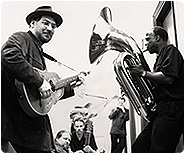|
|
 |
 The Polymorphic Roots of Americana:
The Polymorphic Roots of Americana:
The New York Grit and Lost Instruments of Hazmat Modine
Hazmat Modine is a band of unwanted sounds, lost instruments, and cultural combinations that reflect the origins of the American musical soul. Their debut CD, Bahamut, (to be released on August 29, 2006 by Barbès Records) explores the road not taken, simultaneously conjuring up the familiar, the otherworldly, and the invisible space between. And yet the defining theme of Hazmat is their accessibility as a celebratory band, not a cerebral one.
The band is led by two harmonica-players, rounded out with tuba, drums, guitars, and trumpet, and recruits guests appearing on lesser-known instruments such as the claviola (a strange free-reed instrument), cimbalom (a large hammered dulcimer of Eastern European origin), the contra-bass saxophone, and the sheng (Chinese mouth organ). One minute you might say they are Blues, and the next minute you might think Rocksteady or even Gypsy, but all along you will hear sounds oddly familiar, yet somehow from a time and place that never existed. Hazmat is not aiming for a nostalgic journey, nor a global mish-mosh of sounds. They are looking for authentic sonic communion. This is something the players feel happens best when they are not rigid about the forms of music they take on.
“If you want to be faithful to the music forms that made American music great,” proclaims Hazmat leader Wade Schuman, “you have to be faithful to what made it great, not to the music forms themselves. American music is, by its essence, music that comes out of the so-called melting pot of different cultures banging up against each other. And that was the creative aspect.”
Schuman points out that the first real Blues hit, “St. Louis Blues” by W.C. Handy, included a minor-key tango section. “That is one of the things that makes the song what it is,” says Schuman. He points to the significant influence of Latin and Caribbean music in the 1930s, and the huge influx of immigrants into New York City. “There were few studios in Trinidad,” explains the harmonica-player, vocalist, and guitarist. “Most Calypso musicians were recording in New York, so many of the early Calypso recordings were related in some way to America. The point is that we live in a nostalgic commodified world where we believe that Rock and Roll, or Bluegrass, or Dixieland are rigid music forms not influenced by outside factors. But that is not the history of how American music happened. It’s really quite dynamic, and based on a phenomenal cultural shift in the early part of the 20th century.”
At the same time, Schuman recognizes that regions of America each had their own local flavor. “Without television, and with limited national radio, things didn’t homogenize as fast,” Schuman theorizes. “Things would gestate in a lot of creative ways in different locations. Here in New York, there are these individual music scenes full of incredible musicians. And I do try to tap into all these different spheres.”
Hazmat’s band members come out of many idioms. Guitarist Pete Smith will often give a song a Cuban or Brazilian spin. Veteran tuba player Joseph Daley not only brings a wealth of knowledge from his work as an improvising artist, but is also respected as one of the country’s most creative “lower brass specialists.” Drummer Richard Huntley hops from Latin and Jazz to Klezmer, while Pamela Fleming uses her hot trumpet to bridge everything from the Swing era to soulful Reggae. Guitarist Michael Gomez, who plays every style from ragy finger-picking to Swing-Jazz to Rock and Roll, also plays the Banjitar and the lap steel guitar. While Schuman’s harmonica repertoire evolved out of Pre-War Blues and roots, Randy Weinstein draws on Chicago Blues, Jazz, and World Music.
Beyond its central role in the band, the harmonica is a metaphor for the music they play. The small diatonic harmonica was popularized in Germany as a folk instrument, almost a toy. It was sold in massive quantities and was affordable to American Southerners, both African-American and European-American. “They pulled from it things it was never meant to do,” explains Schuman. “Bending a note is an accident of physics, creating that glissando blue note. An instrument designed for one thing is used in a different way, and a new music form is invented for it.” The harmonica pictured on the cover of the CD is a real instrument from Schuman’s collection, and offers a compelling visual metaphor for the band.
Hazmat Modine exploits a huge musical register and a wide range of instruments not usually played together. A unique musical palette is created by putting the tuba and rare contrabass saxophone—whose low range would be lost in most bands—next to the almost vocal-like sound of the harmonicas. Since there are only about 100 claviolas in existence, putting it next to anything creates a unique experience. Schuman and crew are masters of contrast, and explorers of timbre, but not at the expense of melody and groove.
“I saw some amazing musicians downtown the other night,” recalls Schuman. “Really incredible musicians. But it is so much work to listen to them. I want to seduce the audience. To not only make them feel good, but to move them!”
“There are certain things about American genres like Jazz, Blues, and Country, a certain simplicity and directness that I think are extremely moving and very, very hard to understand. They come from a deep place in the soul of America,” concludes Schuman. “That’s something you have to tap into.”
|
|
 |
|
|
|